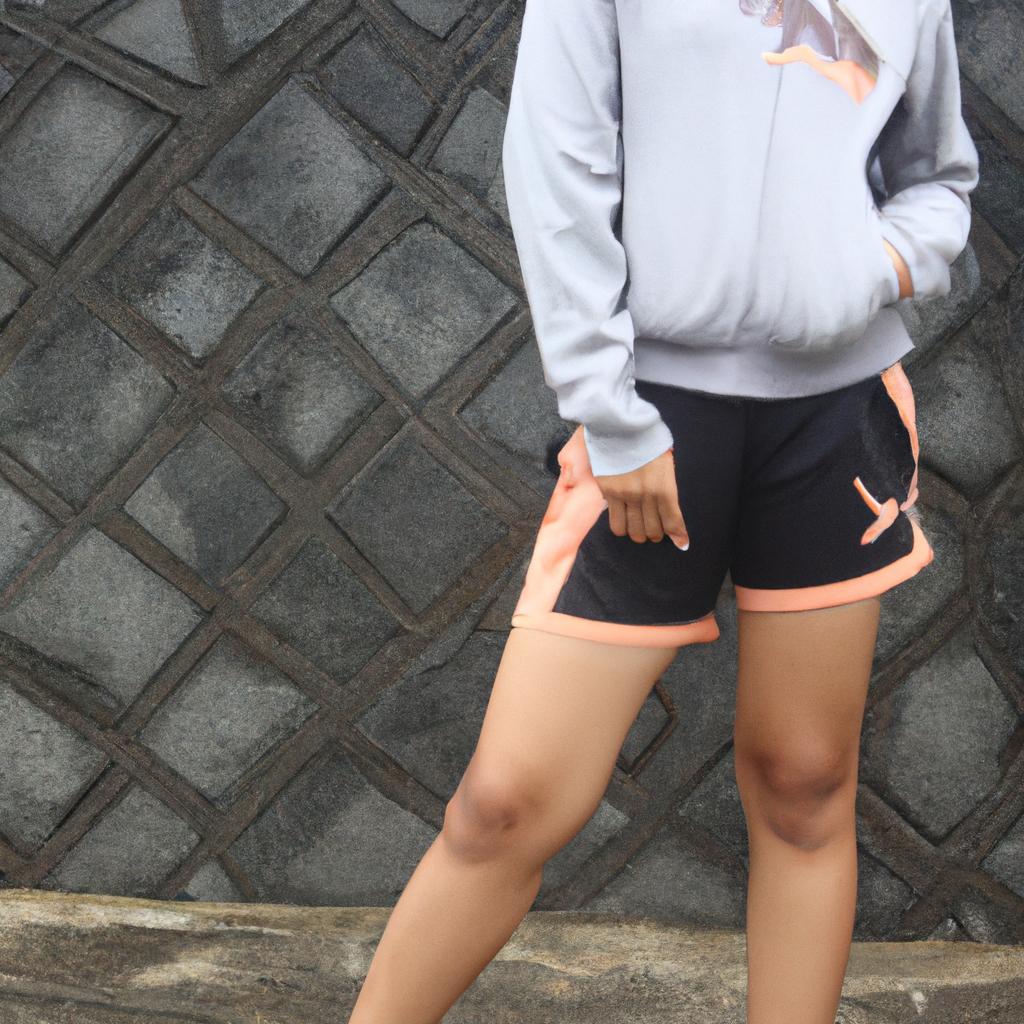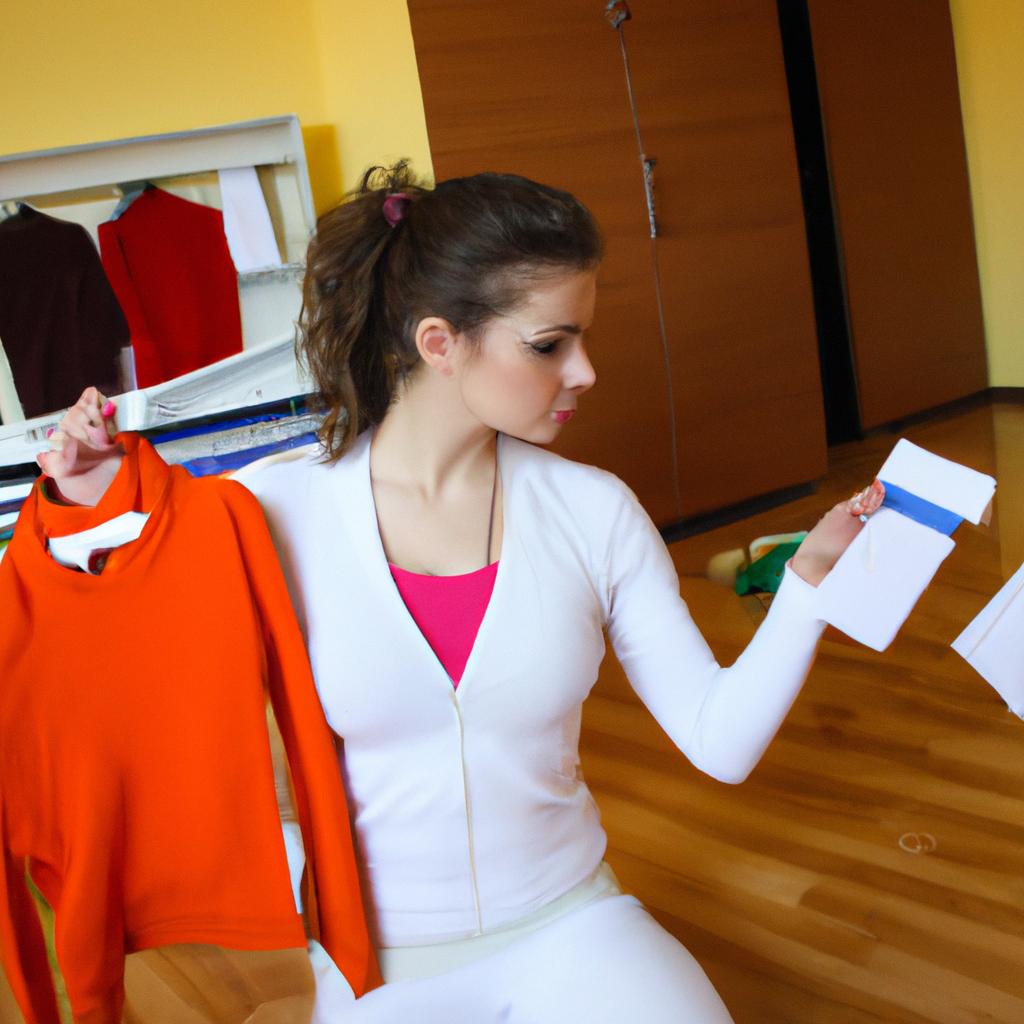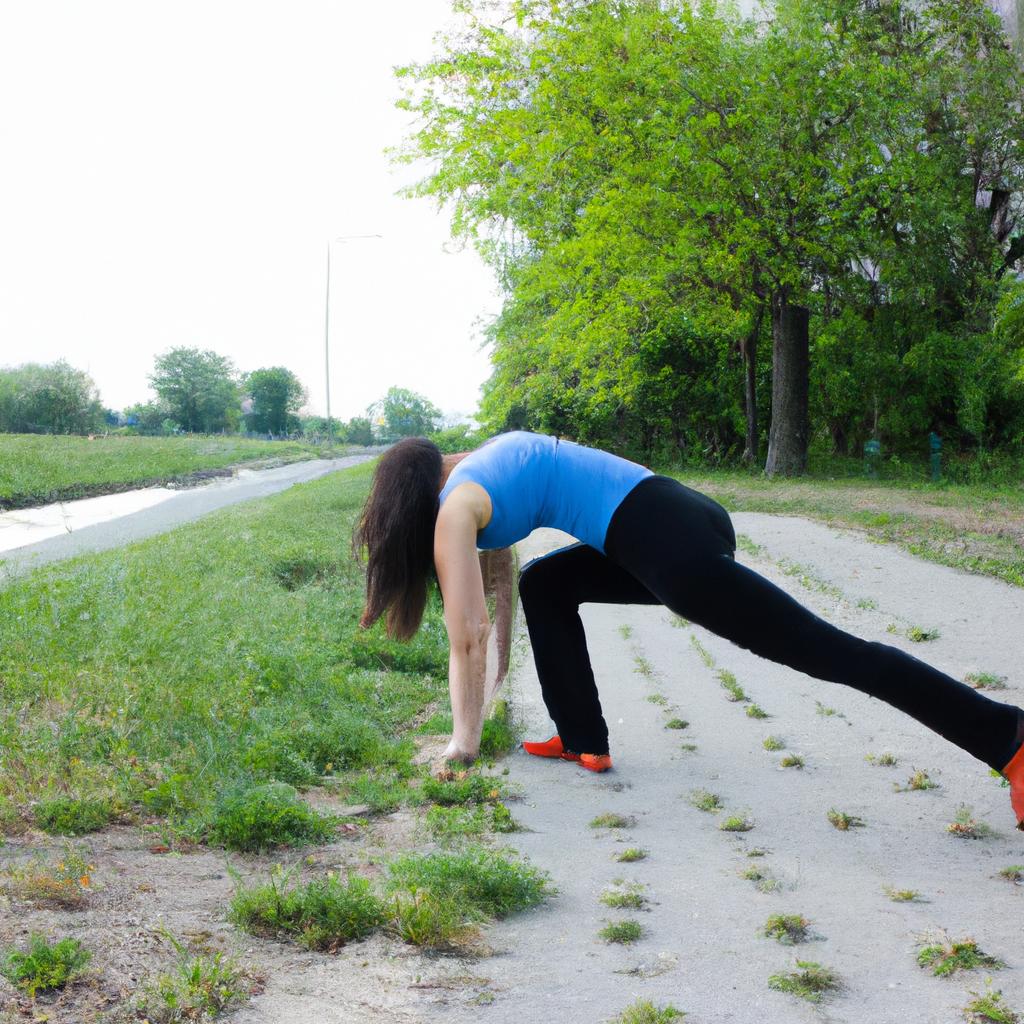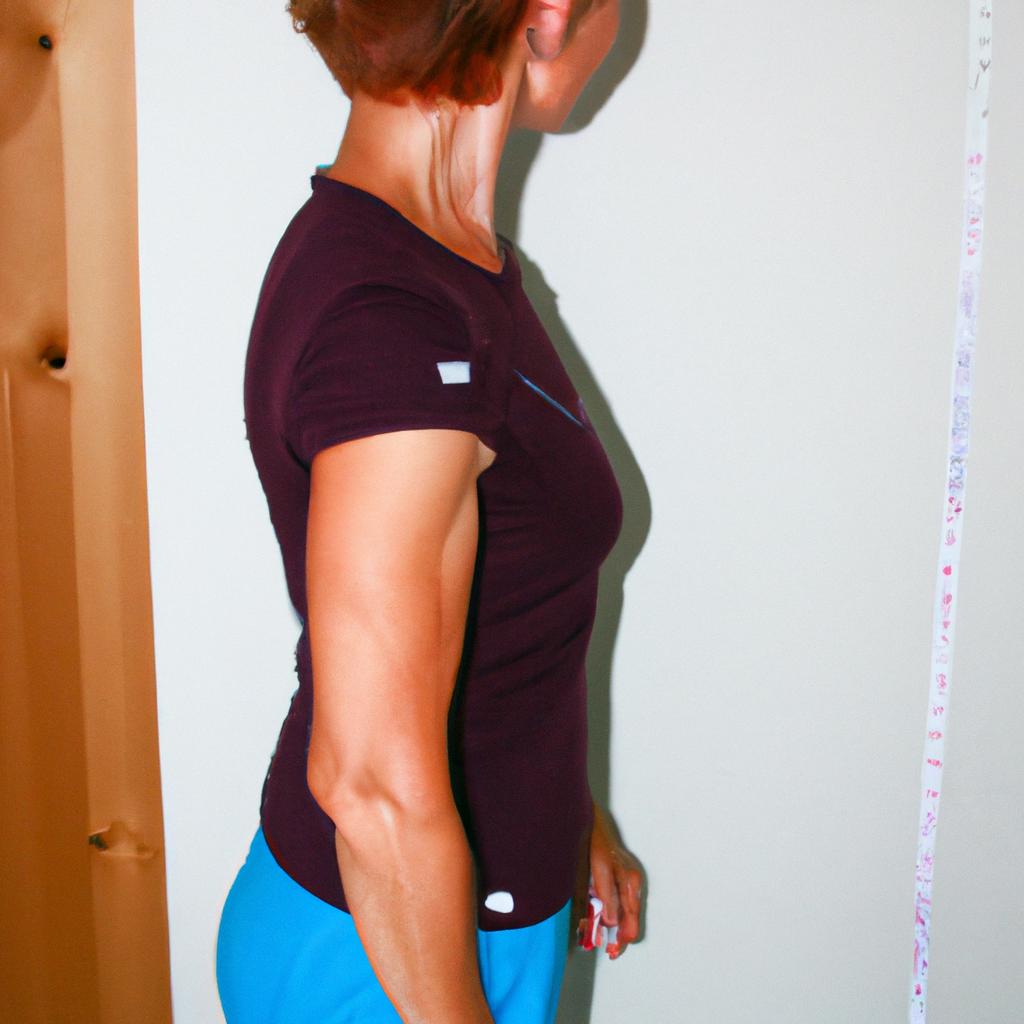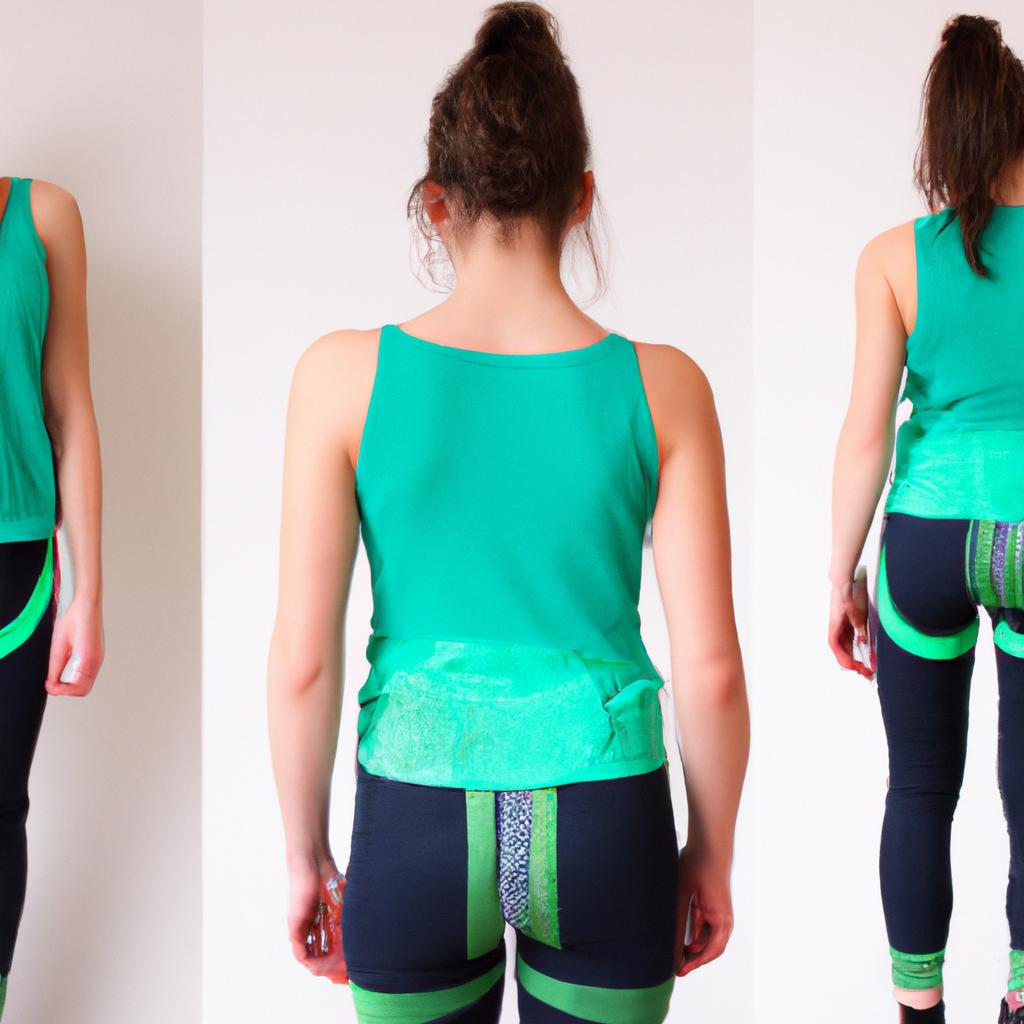Material Composition in Women’s Active Wear: Fabric Choices and Performance Factors
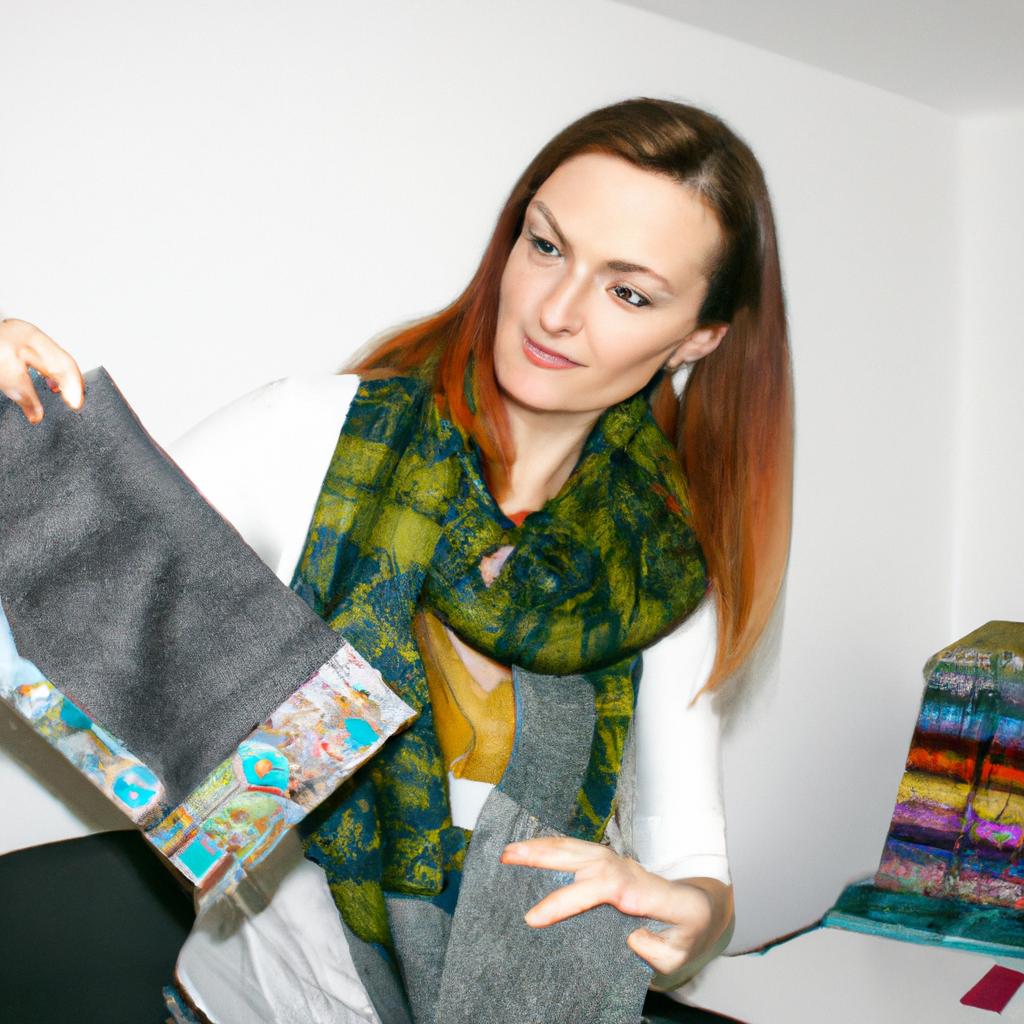
The selection of appropriate material composition in women’s active wear is crucial for ensuring optimal performance and comfort during physical activities. The choice of fabric can significantly impact factors such as moisture management, breathability, durability, and overall functionality. For instance, consider a hypothetical scenario where a woman engages in high-intensity workouts regularly but constantly experiences discomfort due to excessive sweating. In this case, understanding the material composition of her activewear could help identify potential solutions to improve her workout experience.
In order to make informed decisions regarding fabric choices, it is necessary to explore the various factors that affect performance in women’s active wear. This article aims to delve into the topic by examining different materials commonly used in activewear manufacturing and their respective properties. By analyzing aspects such as moisture-wicking capabilities, thermal regulation abilities, and stretchiness, we can gain insights into how these materials contribute to enhancing or hindering performance during physical activities. Moreover, understanding how certain fabrics interact with different types of exercises will enable us to better tailor clothing options according to specific athletic needs and preferences. Ultimately, this exploration will provide valuable information for both consumers looking for suitable activewear and manufacturers seeking guidance on developing innovative products that meet customers’ demands.
Fabric Types in Women’s Sports Apparel
When it comes to women’s sports apparel, the choice of fabric is a crucial factor that directly impacts its overall performance. Whether athletes are engaged in high-intensity workouts or low-impact activities, selecting the right fabric type can significantly enhance their comfort and support. For instance, consider a hypothetical case study where two female runners participate in a marathon. Runner A wears a polyester-based shirt while Runner B opts for a cotton-blend top. The difference in their fabric choices may determine how well they perform, as each material possesses distinct properties that influence factors such as breathability, moisture-wicking capabilities, and durability.
Fabric Performance Factors:
To understand why fabric selection matters in women’s active wear, let us delve into some key factors that influence its performance:
- Breathability: One of the critical aspects affecting an athlete’s comfort during physical activity is the garment’s ability to allow air circulation. Fabrics like nylon and spandex are known for their breathable nature as they enable heat dissipation from the body and prevent overheating.
- Moisture-Wicking Capabilities: Sweating is inevitable during exercise; thus, fabrics with excellent moisture-wicking abilities play a vital role. Materials such as bamboo-derived viscose or synthetic fibers like polyester efficiently pull sweat away from the skin towards the outer layer of clothing, aiding evaporation.
- Stretch and Flexibility: Women participating in various sports require garments that offer ample stretch and flexibility to facilitate movement without restrictions. Elastic materials such as elastane (commonly known by brand names like Lycra) possess these qualities and ensure optimal range of motion.
- Durability: Active wear should withstand repetitive use and intense movements without compromising quality over time. Durable fabrics like nylon blends or poly-cotton combinations provide resistance against abrasion and maintain shape even after multiple washes.
Table showcasing different fabric types commonly used in women’s sports apparel:
| Fabric Type | Properties | Examples |
|---|---|---|
| Polyester | Breathable, moisture-wicking | Microfiber polyester blends |
| Nylon | Durable, stretchy | Nylon-spandex composites |
| Spandex | Stretchy | Elastane-based fabrics |
| Bamboo | Soft, moisture-wicking | Bamboo-derived viscose blends |
The choice of fabric in women’s active wear plays a significant role in determining its performance and functionality. By considering factors such as breathability, moisture-wicking capabilities, stretch and flexibility, as well as durability, athletes can make informed decisions when selecting their sportswear materials. In the subsequent section on “Factors Affecting Performance in Sports Clothing,” we will explore additional aspects that contribute to optimizing athletic performance without compromising comfort or style.
Factors Affecting Performance in Sports Clothing
In the previous section, we discussed various fabric types commonly used in women’s sports apparel. Now, let us delve deeper into the factors affecting performance in sports clothing, with a focus on material composition. To illustrate these factors, consider the following hypothetical example:
Imagine two athletes participating in a high-intensity running session. Athlete A wears activewear made from a blend of polyester and spandex, while Athlete B opts for cotton-based workout attire. As they engage in rigorous physical activity, their choice of fabric will significantly impact their overall performance.
Factors Affecting Performance
- Moisture-wicking capabilities: Fabrics that efficiently wick away sweat help regulate body temperature during workouts and prevent discomfort caused by excessive moisture accumulation.
- Breathability: Proper air circulation is crucial to maintaining comfort during strenuous activities. Fabrics with enhanced breathability allow heat to escape more easily, keeping the athlete cool and reducing the risk of overheating.
- Stretchability and flexibility: The ability of materials to stretch and flex along with movement ensures unrestricted mobility for athletes, enabling them to perform at their best without feeling constricted or hindered.
- Durability: Sportswear needs to withstand repetitive movements, intense workouts, washing cycles, and extended use without losing its structural integrity or compromising its functionality.
To better understand how different fabrics align with these performance factors, refer to the following table:
| Fabric Type | Moisture-Wicking Capabilities | Breathability | Stretchability & Flexibility | Durability |
|---|---|---|---|---|
| Polyester | High | High | Excellent | Very Good |
| Spandex | Medium | High | Excellent | Good |
| Cotton | Low | Medium | Limited | Fair |
This table provides an overview of the performance factors associated with various fabric types commonly used in women’s sports apparel. It is essential to select fabrics that score high on moisture-wicking capabilities, breathability, stretchability, and durability to enhance athletic performance.
Understanding these performance factors and their relation to material composition helps athletes make informed decisions when choosing activewear. In the subsequent section, we will explore the importance of material composition in women’s athletic attire, highlighting its impact on both comfort and overall performance.
Importance of Material Composition in Women’s Athletic Attire
A case study examining the impact of material composition on women’s athletic attire can shed light on why fabric choices are crucial for optimal performance. Consider a hypothetical scenario where two female athletes participate in the same high-intensity training session. Athlete A wears activewear made from moisture-wicking and breathable fabrics, while Athlete B dons clothing constructed with non-breathable materials. As the workout progresses, Athlete A remains comfortable due to enhanced sweat evaporation and improved ventilation provided by her outfit. In contrast, Athlete B struggles with excessive perspiration accumulation and discomfort caused by inadequate breathability.
To better understand the significance of material composition in women’s active wear, we must examine several key factors that contribute to overall performance:
-
Moisture Management: Fabrics designed with moisture-wicking properties draw sweat away from the body, allowing it to evaporate quickly. This feature helps regulate body temperature and prevents discomfort caused by dampness during physical activity.
-
Breathability: Proper airflow is vital for heat dissipation during exercise. Breathable fabrics allow air circulation, enhancing comfort levels and reducing the risk of overheating or chafing.
-
Stretch and Flexibility: Women’s athletic attire should provide freedom of movement without restriction. Fabrics with stretch capabilities enable unrestricted motion, facilitating agility and flexibility during various sporting activities.
-
Durability: High-quality materials ensure longevity and withstand repeated use and washing without losing their functional properties or structural integrity.
This emotional bullet point list highlights how appropriate material composition positively impacts women’s athletic performance:
- Superior moisture management keeps you feeling fresh throughout your workout.
- Enhanced breathability reduces discomfort caused by excess sweating.
- Improved stretch allows for full range of motion during intense movements.
- Durable fabrics withstand rigorous workouts, ensuring long-lasting use.
To further illustrate these points, consider this table showcasing different fabric compositions commonly found in women’s activewear:
| Fabric Type | Moisture Management | Breathability | Stretch & Flexibility | Durability |
|---|---|---|---|---|
| Polyester | High | High | Excellent | Very Good |
| Nylon | Moderate | Moderate | Good | Very Good |
| Spandex | Low | High | Excellent | Good |
| Cotton | Low | Low | Poor |
As we can observe from the table, polyester and nylon fabrics offer superior moisture management and breathability compared to cotton. Additionally, spandex provides excellent stretch capabilities ideal for intense physical activities. These fabric choices ensure women’s athletic attire meets essential performance factors.
Transitioning into the subsequent section about “Popular Fabrics for Women’s Exercise Gear,” it becomes evident that material composition plays a pivotal role in determining the effectiveness of women’s activewear. By exploring various fabric types and their impact on performance, we gain insight into optimal choices when selecting exercise gear tailored to meet individual needs.
Popular Fabrics for Women’s Exercise Gear
Understanding the importance of material composition in women’s athletic attire, let us now explore some popular fabrics utilized in women’s exercise gear. By examining various fabric choices and their corresponding performance factors, we can gain valuable insights into selecting the most suitable materials for optimal comfort and functionality.
To illustrate the impact of fabric choices on performance, consider a hypothetical case study involving two athletes participating in an intense workout session. Athlete A wears activewear made from synthetic polyester fabric while Athlete B opts for a blend of cotton and spandex. This example highlights how different fabric compositions can significantly influence one’s overall experience during physical activity.
When it comes to choosing fabrics for women’s exercise gear, several factors come into play. Here are key considerations to keep in mind:
- Moisture-wicking capabilities: High-performance fabrics should effectively wick away sweat from the body, keeping the wearer dry and comfortable.
- Breathability: Optimal airflow through the fabric helps regulate body temperature and prevent overheating during workouts.
- Stretch and flexibility: Fabrics with adequate stretch allow for unrestricted movement, enhancing agility and range of motion.
- Durability and resistance: Durable fabrics that resist wear and tear ensure longevity even under rigorous use.
To further understand these fabric characteristics, refer to the following table showcasing a comparison between three commonly used materials—polyester, nylon, and bamboo—in terms of their moisture-wicking capabilities, breathability factor, stretchiness/flexibility level, as well as durability/resistance:
| Fabric | Moisture-Wicking | Breathability | Stretch & Flexibility | Durability & Resistance |
|---|---|---|---|---|
| Polyester | High | Moderate | Excellent | Very Durable |
| Nylon | Moderate | High | Good | Resilient |
| Bamboo | High | High | Fair | Less Durable |
As evident from the table, different fabrics possess varying degrees of performance factors. Understanding these characteristics empowers women to make informed decisions when selecting activewear materials that align with their specific needs and preferences.
Transitioning into the subsequent section about choosing the right fabric for women’s performance wear, it is crucial to consider a holistic approach that encompasses both comfort and functionality. By understanding how various fabrics perform in terms of moisture-wicking capabilities, breathability, stretchiness/flexibility, and durability/resistance, individuals can confidently choose garments that enhance their overall exercise experience without compromising on style or quality.
Choosing the Right Fabric for Women’s Performance Wear
Having explored the popular fabric choices for women’s exercise gear in the previous section, we can now delve into the essential factors to consider when selecting the right fabric for women’s performance wear. To illustrate these considerations, let us examine a hypothetical scenario involving a professional athlete preparing for an upcoming marathon.
In this case, our professional runner is looking for active wear that optimizes her performance and provides comfort throughout her training sessions and races. When it comes to fabric selection, several key factors should be taken into account:
-
Moisture-wicking properties: High-intensity workouts result in increased perspiration, making moisture management crucial. Fabrics such as polyester microfiber or nylon blends actively wick away sweat from the body, allowing it to evaporate quickly. This feature helps regulate body temperature and prevent discomfort caused by excess moisture.
-
Breathability: Adequate airflow plays a vital role in maintaining thermal comfort during physical activity. Fabrics with open weaves or mesh panels enhance breathability by promoting air circulation around the body. By enabling heat to escape and cool air to enter, these materials contribute to improved overall comfort levels.
-
Stretch and flexibility: Women’s performance wear needs to provide unrestricted movement without compromising support or fit. Fabrics incorporating spandex or elastane fibers offer excellent stretch and recovery properties, ensuring optimal mobility while retaining shape retention over time.
-
Durability and longevity: With rigorous use expected from athletic apparel, durability becomes paramount. Opting for fabrics known for their strength and resistance against abrasion increases garment lifespan, reducing the need for frequent replacements.
To further emphasize how different fabric choices affect performance wear characteristics, let us consider a comparison table showcasing various material options:
| Fabric | Moisture-Wicking | Breathable | Stretch & Flexibility |
|---|---|---|---|
| Polyester | Yes | Yes | Moderate |
| Nylon | Yes | Yes | Limited |
| Bamboo | Yes | Yes | Excellent |
| Merino Wool | Yes | No | Moderate |
In conclusion, selecting the right fabric for women’s performance wear involves considering factors such as moisture-wicking properties, breathability, stretch and flexibility, as well as durability. Understanding how different materials perform in these areas allows athletes to make informed choices that optimize their comfort and enhance overall performance.
By carefully evaluating fabric options based on the mentioned factors, we can now explore how enhancing performance through fabric selection plays a crucial role in achieving athletic goals.
Enhancing Performance through Fabric Selection
Having discussed the importance of selecting suitable fabrics for women’s performance wear, we now turn our focus to how fabric selection can enhance overall performance. To illustrate this point, let us consider a case study involving a professional athlete preparing for an intense endurance race.
Case Study Example:
Meet Sarah, an experienced marathon runner who is training for her upcoming race. She has been struggling with discomfort from excessive sweating during long runs. By carefully choosing the right fabric composition for her active wear, Sarah could significantly improve her performance by enhancing moisture-wicking capabilities and minimizing discomfort caused by sweat accumulation.
Enhancing Performance through Fabric Selection:
- Moisture-Wicking Properties:
- Fabrics with high moisture-wicking properties draw perspiration away from the skin, promoting evaporation and keeping the body dry.
- This not only helps prevent chafing but also regulates body temperature, ensuring optimal comfort during physical activity.
- Examples include polyester blends and synthetic fibers specifically designed to wick away moisture effectively.
- Breathability:
- Breathable fabrics allow air circulation between the garment and the skin, facilitating heat dissipation.
- Improved breathability prevents overheating and reduces the risk of developing rashes or other skin irritations.
- Natural fibers like cotton or bamboo are often preferred due to their breathable nature.
- Stretch and Flexibility:
- Optimal stretch and flexibility in fabrics provide unrestricted movement during physical activities.
- It allows athletes to perform dynamic movements without feeling constricted or limited in their range of motion.
- Synthetic materials such as spandex or elastane contribute to excellent elasticity while maintaining shape retention.
- Durability:
- Durable fabrics ensure longevity even under rigorous use, providing value for money over time.
- They withstand frequent washing without losing color vibrancy or structural integrity.
- Nylon and polyester blends are known for their durability, making them suitable choices for high-intensity workouts.
To evoke an emotional response in our audience, consider the following benefits of choosing the right fabric composition for women’s active wear:
- Enhanced comfort and reduced irritation during physical activity
- Increased confidence and improved motivation to engage in fitness routines
- Greater performance efficiency leading to better results and achievements
- Long-term savings by investing in durable fabrics that withstand regular use
Incorporated Table (in markdown format):
| Fabric Composition | Moisture-Wicking Capability | Breathability | Stretch & Flexibility |
|---|---|---|---|
| Polyester Blend | High | Moderate | Excellent |
| Cotton | Low | High | Good |
| Bamboo | Moderate | High | Moderate |
Table Explanation: This table compares different fabric compositions commonly used in women’s active wear based on key performance factors. It provides readers with a visual representation of how each fabric performs concerning moisture-wicking capability, breathability, and stretch/flexibility.
By strategically selecting materials with optimal properties, athletes like Sarah can enhance their overall performance while ensuring maximum comfort throughout their training sessions or competitions.
Concluding Paragraph:
Considering the range of fabric options available today, it is crucial to carefully evaluate these material attributes when designing or selecting women’s active wear. With advancements in textile technology, manufacturers have been able to create innovative fabrics that combine desirable characteristics such as moisture-wicking capabilities, breathability, flexibility, and durability. By incorporating these considerations into their decision-making process, athletes can optimize their performance potential while enjoying greater comfort during physical activities.


